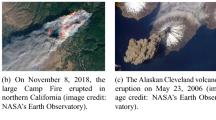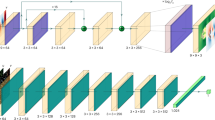Abstract
We propose a new approach to the optimal placement of sensors for the problem of reconstructing geophysical fields from sparse measurements. Our method consists of two stages. In the first stage, we estimate the variability of the physical field as a function of spatial coordinates by approximating its information entropy through the Conditional PixelCNN network. To calculate the entropy, a new ordering of a two-dimensional data array (spiral ordering) is proposed, which makes it possible to obtain the entropy of a physical field simultaneously for several spatial scales. In the second stage, the entropy of the physical field is used to initialize the distribution of optimal sensor locations. This distribution is further optimized with the Concrete Autoencoder architecture with the straight-through gradient estimator and adversarial loss to simultaneously minimize the number of sensors and maximize reconstruction accuracy. Our method scales linearly with data size, unlike commonly used Principal Component Analysis. We demonstrate our method on the two examples: (a) temperature and (b) salinity fields around the Barents Sea and the Svalbard group of islands. For these examples, we compute the reconstruction error of our method and a few baselines. We test our approach against two baselines (1) PCA with QR factorization and (2) climatology. We find out that the obtained optimal sensor locations have clear physical interpretation and correspond to the boundaries between sea currents.
Access this chapter
Tax calculation will be finalised at checkout
Purchases are for personal use only
Similar content being viewed by others
References
Kaurkin, M.N., Ibrayev, R.A.: Multivariate EnOI-based data assimilation in the high resolution ocean model. J. Phys.: Conf. Ser. 1128(1), 012144 (2018). IOP Publishing
Nakai, K., et al.: Effect of objective function on data-driven greedy sparse sensor optimization. IEEE Access 9, 46731–46743 (2021)
Saito, Y., et al.: Determinant-based fast greedy sensor selection algorithm. IEEE Access 9, 68535–68551 (2021)
Wolf, P., Moura, S., Krstic, M.: On optimizing sensor placement for spatio-temporal temperature estimation in large battery packs. In: Proceedings of the IEEE Conference on Decision Control (CDC), pp. 973–978 (2012). https://doi.org/10.1109/CDC.2012.6426191
Kumar, P., Sayed, Y.M.E., Semaan, R.: Optimized sensor placement using stochastic estimation for a flow over a 2D airfoil with Coanda blowing. In: Proceedings of the 7th AIAA Flow Control Conference, Atlanta, GA, USA (2014)
Krause, A., Singh, A., Guestrin, C.: Near-optimal sensor placements in Gaussian processes: theory, efficient algorithms and empirical studies. J. Mach. Learn. Res. 9(2), 235–284 (2008)
Nguyen, L.V., Guoqiang, H., Spanos, C.J.: Efficient sensor deployments for spatio-temporal environmental monitoring. IEEE Trans. Syst. Man. Cybern.: Syst. 50(12), 5306–5316 (2018)
Nagata, T., et al.: Data-driven sparse sensor selection based on A-optimal design of experiment with ADMM. IEEE Sens. J. 21(13), 15248–15257 (2021)
Jang, E., Gu, S., Poole, B.: Categorical reparameterization with Gumbel-Softmax. arXiv preprint arXiv:1611.01144 (2016)
Maddison, C.J., Mnih, A., Teh, Y.W.: The concrete distribution: a continuous relaxation of discrete random variables. arXiv preprint arXiv:1611.00712 (2016)
Wang, Z.-K., et al.: Optimization and assessment of blade tip timing probe layout with concrete autoencoder and reconstruction error. Appl. Soft Comput. 119, 108590 (2022)
Balın, M.F., Abid, A., Zou, J.: Concrete autoencoders: differentiable feature selection and reconstruction. In: International Conference on Machine Learning. PMLR (2019)
Huijben, I.A.M., Veeling, B.S., van Sloun, R.J.G.: Deep probabilistic subsampling for task-adaptive compressed sensing. In: International Conference on Learning Representations (2019)
Singh, D., et al.: FsNet: feature selection network on high-dimensional biological data. arXiv preprint arXiv:2001.08322 (2020)
Van den Oord, A., et al.: Conditional image generation with PixelCNN decoders. In: Advances in Neural Information Processing Systems, vol. 29 (2016)
Van Oord, A., Kalchbrenner, N., Kavukcuoglu, K.: Pixel recurrent neural networks. In: International Conference on Machine Learning. PMLR (2016)
Isola, P., et al.: Image-to-image translation with conditional adversarial networks. In: Proceedings of the IEEE Conference on Computer Vision and Pattern Recognition (2017)
Ronneberger, O., Fischer, P., Brox, T.: U-Net: convolutional networks for biomedical image segmentation. In: Navab, N., Hornegger, J., Wells, W.M., Frangi, A.F. (eds.) MICCAI 2015. LNCS, vol. 9351, pp. 234–241. Springer, Cham (2015). https://doi.org/10.1007/978-3-319-24574-4_28
Kalnitskii, L., Kaurkin, M., Ushakov, K., Ibrayev, R.: Supercomputer implementation of a high resolution coupled ice-ocean model for forecasting the state of the Arctic Ocean. In: Voevodin, V., Sobolev, S. (eds.) RuSCDays 2020. CCIS, vol. 1331, pp. 332–340. Springer, Cham (2020). https://doi.org/10.1007/978-3-030-64616-5_29
Zacharov, I., et al.: “Zhores” - petaflops supercomputer for data-driven modeling, machine learning and artificial intelligence installed in Skolkovo Institute of Science and Technology. Open Eng. 9(1), 512–520 (2019). https://doi.org/10.1515/eng-2019-0059
Bryan, K.: A numerical method for the study of the circulation of the world ocean. J. Comput. Phys. 135(2), 154–169 (1997). https://doi.org/10.1016/0021-9991(69)90004-7
Lebedev, V.I.: Difference analogues of orthogonal decompositions, basic differential operators and some boundary problems of mathematical physics. I. USSR Comput. Math. Math. Phys. 4(3), 69–92 (1964). https://doi.org/10.1016/0041-5553(64)90240-X
Lebedev, V.I.: Difference analogues of orthogonal decompositions, basic differential operators and some boundary problems of mathematical physics. II. USSR Comput. Math. Math. Phys. 4(4), 36–50 (1964). https://doi.org/10.1016/0041-5553(64)90003-5
Mesinger, F., Arakawa, A.: Numerical Methods Used in Atmospheric Models. GARP Publ. Series # 17, vol. I, p. 64 pp. WMO/ISCU Joint Org. Committee, Geneva (1976)
Ushakov, K.V., Ibrayev, R.A.: Assessment of mean world ocean meridional heat transport characteristics by a high-resolution model. Russ. J. Earth. Sci. 18, ES1004 (2018). https://doi.org/10.2205/2018ES000616
Hunke, E.C., Lipscomb, W.H., Turner, A.K., Jeffery, N., Elliott, S.: CICE: the Los Alamos Sea Ice Model documentation and software user’s manual, version 5.1. Technical report LA-CC-06-012. Los Alamos National Laboratory, Los Alamos, NM (2015). http://www.ccpo.odu.edu/klinck/Reprints/PDF/cicedoc2015.pdf
Killworth, P.D., et al.: The development of a free-surface Bryan-Cox-Semtner ocean model. J. Phys. Oceanogr. 21(9), 1333–1348 (1991)
Griffies, S.M., Hallberg, R.W.: Biharmonic friction with a Smagorinsky-like viscosity for use in large-scale eddy-permitting ocean models. Mon. Weather Rev. 128, 2935–2946 (2000). https://doi.org/10.1175/1520-0493(2000)1282935:BFWASL2.0.CO;2
Munk, W.H., Anderson, E.R.: Note on the theory of the thermocline. J. Mar. Res. 7, 276–295 (1948)
Griffies, S.M., et al.: Coordinated ocean-ice reference experiments (COREs). Ocean Model. 26(1–2), 1–46 (2009). https://doi.org/10.1016/j.ocemod.2008.08.007
Hersbach, H., Bell, B., Berrisford, P., et al.: The ERA5 global reanalysis. Q. J. R. Meteorol. Soc. 146(730), 1999–2049 (2020)
Manohar, K., et al.: Data-driven sparse sensor placement for reconstruction: demonstrating the benefits of exploiting known patterns. IEEE Control Syst. Mag. 38(3), 63–86 (2018)
Ryan, A.G., et al.: GODAE OceanView Class 4 forecast verification framework: global ocean inter-comparison. J. Oper. Oceanogr. 8(sup1), s98–s111 (2015). https://doi.org/10.1080/1755876X.2015.1022330
Acknowledgements
This research was funded by the state assignment of IO RAS, theme FMWE-2021-0003 (analysis of the temperature and salinity fields near the Svalbard group of islands, final experiments and assessment of reconstruction accuracy for the considered optimal sensor placement methods), and by the BASIS Foundation, Grant No. 19-1-1-48-1 (development of the information entropy approximation scheme and initial experiments with the concrete autoencoder by A. L.). The authors acknowledge the use of Zhores HPC [20] for obtaining the results presented in this paper. The ocean model dataset was obtained using supercomputer resources of JSCC RAS and INM RAS.
Author information
Authors and Affiliations
Corresponding author
Editor information
Editors and Affiliations
Rights and permissions
Copyright information
© 2022 The Author(s), under exclusive license to Springer Nature Switzerland AG
About this paper
Cite this paper
Turko, N., Lobashev, A., Ushakov, K., Kaurkin, M., Ibrayev, R. (2022). Information Entropy Initialized Concrete Autoencoder for Optimal Sensor Placement and Reconstruction of Geophysical Fields. In: Voevodin, V., Sobolev, S., Yakobovskiy, M., Shagaliev, R. (eds) Supercomputing. RuSCDays 2022. Lecture Notes in Computer Science, vol 13708. Springer, Cham. https://doi.org/10.1007/978-3-031-22941-1_12
Download citation
DOI: https://doi.org/10.1007/978-3-031-22941-1_12
Published:
Publisher Name: Springer, Cham
Print ISBN: 978-3-031-22940-4
Online ISBN: 978-3-031-22941-1
eBook Packages: Computer ScienceComputer Science (R0)




